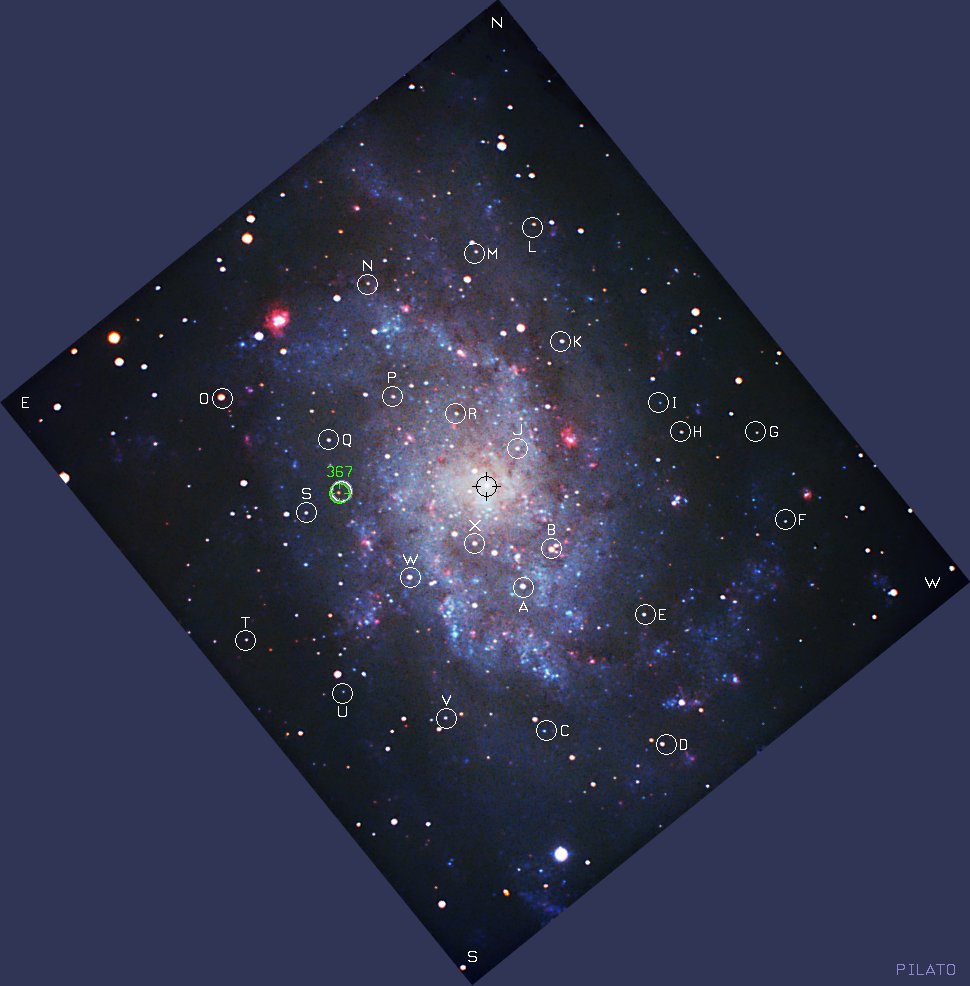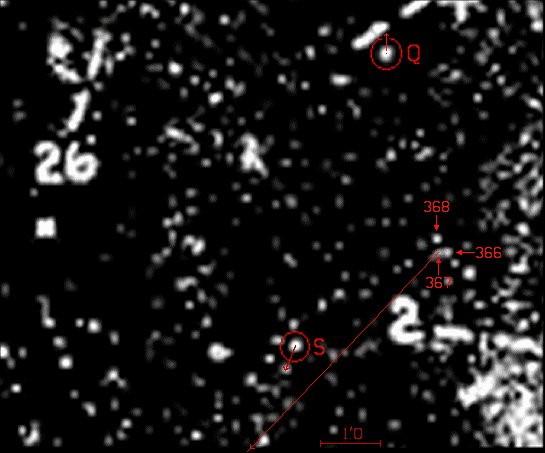Messier 33 Showing van Maanen's Comparison Stars - Pilato

2003 Astrograph courtesy of Dark Star Images by Tony Pilato
This image has been rotated 51 degrees clockwise to orient it
with North at the top. (50.5 degrees is closer to what's needed.)

This image has been rotated 51 degrees clockwise to orient it
with North at the top. (50.5 degrees is closer to what's needed.)
|
Van Maanen's x,y object coordinates are rounded off to the nearest 0.1 arcmin(1). The author of this page has tweaked the rounded off values (up to plus-or-minus 0.04 arcmins) for the comparison star data to improve matching of their scaled positions in relation to the actual photographic positions. The tweaking was done with respect to Humason's 1922 astrograph, using least squares fitting. The results were carried forward to the excel file above. In the excel file, columns B and C are the rounded originals; columns D and E are the tweaked values. The following blink comparator shows apparent confirmation of one of van Maanen's proper motion measurements done in connection with his study of M33.

Images being compared: Ritchey 1910(2) - Hale 1980(3) - Pilato 2003(4) Van Maanen's annotated velocity vectors on Humason's 1922 astrograph(1) tend to obscure the locations of his naked objects. A NADS copy of Ritchey's 1910 M33 astrograph, published by Edwin Hubble in 1926(2), is used to show those locations. Ritchey's image has been enlarged by a factor of four using Paint Shop Pro 7. Paint Shop's bi-cubic pixel resampling gives the image a more natural appearance as compared to the coarse pixelation in the original online copy. van Maanen's rapidly moving star, No. 367, is identified on Ritchey's 1910 image by the short red arrow. No. 367 appears to be the orange star in Pilato's 2003 image(4). (According to van Maanen, No. 367 turns out to be a field star, and is moving about two and a half times faster than the fastest objects that he associated with the nebula. The long red arrow (which extends off the bottom edge of the comparator's field of view) is meant to duplicate van Maanen's velocity vector for No. 367. Velocity vectors for comparison stars Q and S are also shown. The lengths of all velocity vectors depict how far the objects should move in 2500 years. Prior to 15 September 2005, the author of this page had been mis-identifying van Maanen's fast mover, object No. 367, on Ritchey's 1910 image. The wrongly identified object, which is really object No. 368, is located 0.2 arcmins north of No. 367, and appears much more star-like than the wispy 1910 image of No. 367. [Added 15 September 2005.] A Hale Observatories color astrograph made in 1980 or earlier shows object No. 367 (the fast mover) in an intermediate position between its 1910 and 2003 positions. Hale Observatories has kindly granted permission to use a scanned version of the M33 image reproduced in Ferris's book Galaxies(2). [Added 15 September 2005. Updated 20 September 2005.] Van Maanen's proper motion measures for object No. 367 are +95 mas/yr RA, and -98 mas/yr DEC.
References(2) Hubble, Edwin, "A Spiral Nebula as a Stellar System," Contributions from the Mt. Wilson Observatory," No. 310, 1 (1926). NADS - Reprinted from the Astrophysical Journal, 63, pp. 236-274, (1926). (3) Ferris, Timothy, Galaxies, Harrison House, New York, p. 73, (1987), M33 image(1980 or earlier). Scanned image from Ferris's book is used with the permission of the Hale Observatories. (4) 2003 astrograph of M33 courtesy of Dark Star Images by Tony Pilato.
Installed 19 June 2005. Latest update 20 September 2005. |